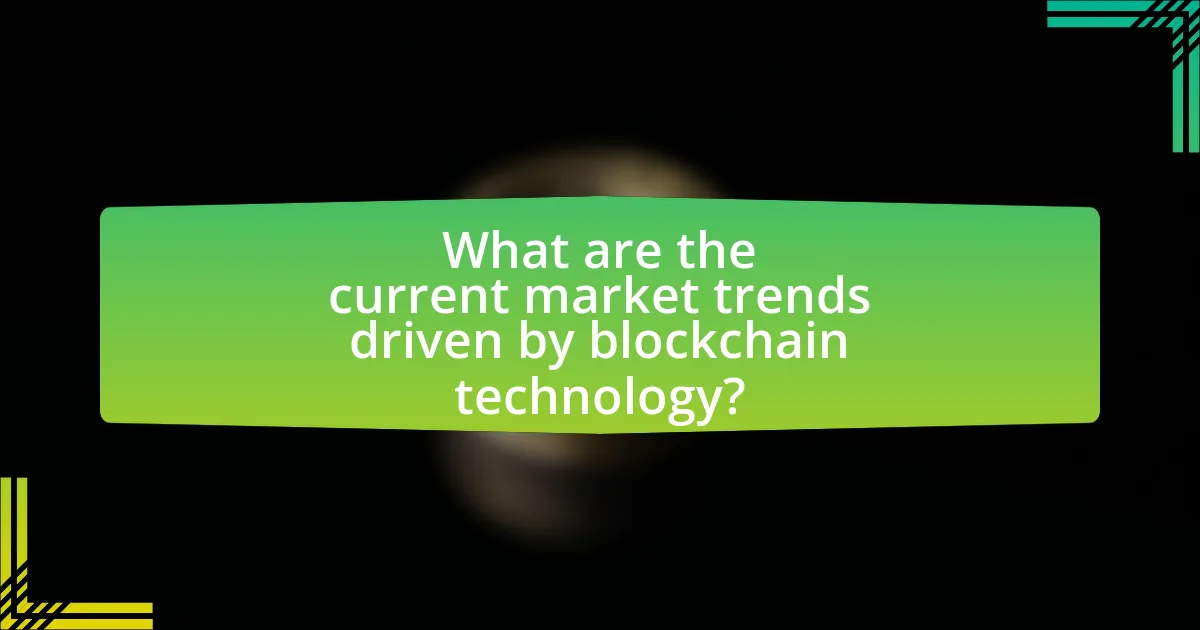Blockchain technology is increasingly influencing current market trends by enhancing transparency, security, and efficiency across various sectors, including finance, supply chain management, and healthcare. Its decentralized nature allows for secure transactions without intermediaries, leading to significant cost reductions and improved operational efficiency. Key features such as immutability and transparency foster trust among market participants, while the rise of decentralized finance (DeFi) and non-fungible tokens (NFTs) exemplifies the transformative impact of blockchain. Despite facing challenges like scalability and regulatory uncertainty, the future prospects for blockchain technology remain strong, with anticipated growth in its adoption and integration across industries.

What is the Role of Blockchain Technology in Current Market Trends?
Blockchain technology plays a crucial role in current market trends by enhancing transparency, security, and efficiency in various sectors. Its decentralized nature allows for secure transactions without intermediaries, which is particularly valuable in finance, supply chain management, and healthcare. For instance, a report by Deloitte indicates that 40% of organizations are considering blockchain for supply chain improvements, highlighting its growing adoption. Additionally, the global blockchain market is projected to reach $163.24 billion by 2029, according to Fortune Business Insights, demonstrating its significant impact on market dynamics.
How does blockchain technology influence market dynamics?
Blockchain technology influences market dynamics by enhancing transparency, reducing transaction costs, and enabling decentralized finance. The transparency provided by blockchain allows all participants to access the same information, which reduces information asymmetry and builds trust among market players. For instance, a study by the World Economic Forum in 2020 highlighted that blockchain could reduce transaction costs by up to 90% in certain sectors, such as cross-border payments. Additionally, the rise of decentralized finance (DeFi) platforms, which leverage blockchain to offer financial services without intermediaries, has created new market opportunities and altered traditional financial systems. This shift is evidenced by the rapid growth of DeFi, which reached over $80 billion in total value locked by mid-2021, demonstrating the significant impact of blockchain on market dynamics.
What are the key features of blockchain that impact market trends?
The key features of blockchain that impact market trends include decentralization, transparency, security, and immutability. Decentralization allows for peer-to-peer transactions without intermediaries, reducing costs and increasing efficiency, which can drive market participation. Transparency ensures that all transactions are visible to participants, fostering trust and accountability, which can enhance market stability. Security is provided through cryptographic techniques that protect data integrity and prevent fraud, making blockchain attractive for various industries, thus influencing market dynamics. Immutability guarantees that once data is recorded, it cannot be altered, which is crucial for maintaining accurate records and compliance, further shaping market behaviors. These features collectively contribute to the growing adoption of blockchain across sectors, impacting investment trends and consumer confidence.
How does decentralization in blockchain affect market operations?
Decentralization in blockchain significantly enhances market operations by eliminating intermediaries, which reduces transaction costs and increases efficiency. This shift allows for peer-to-peer transactions, enabling faster settlements and greater accessibility for participants. For instance, a study by the World Economic Forum in 2020 indicated that blockchain technology could reduce transaction costs by up to 40% in certain sectors. Additionally, decentralization fosters transparency and trust, as all transactions are recorded on a public ledger, making it difficult to manipulate data. This transparency can lead to increased market participation and liquidity, as participants feel more secure in their transactions.
Why is blockchain technology gaining traction in various industries?
Blockchain technology is gaining traction in various industries due to its ability to enhance transparency, security, and efficiency in transactions. This decentralized ledger system allows for immutable record-keeping, which reduces fraud and increases trust among participants. For instance, in supply chain management, companies like IBM and Maersk have implemented blockchain to track goods in real-time, resulting in a 20% reduction in costs and improved accountability. Additionally, the financial sector is leveraging blockchain for faster cross-border payments, with firms like Ripple demonstrating transaction speeds of under five seconds compared to traditional methods that can take days. These advancements illustrate how blockchain addresses critical challenges across sectors, driving its adoption.
Which sectors are most affected by blockchain adoption?
The sectors most affected by blockchain adoption include finance, supply chain management, healthcare, and real estate. In finance, blockchain enhances transaction security and reduces costs through decentralized ledgers, evidenced by the rise of cryptocurrencies and blockchain-based payment systems. Supply chain management benefits from increased transparency and traceability, as seen in companies like IBM and Walmart utilizing blockchain to track product origins. In healthcare, blockchain improves data sharing and patient privacy, with initiatives like MedRec demonstrating secure patient record management. Real estate experiences streamlined property transactions and reduced fraud risks through smart contracts, as evidenced by platforms like Propy.
How does blockchain enhance transparency and trust in markets?
Blockchain enhances transparency and trust in markets by providing a decentralized and immutable ledger that records all transactions. This technology ensures that every transaction is visible to all participants, reducing the likelihood of fraud and manipulation. For instance, in supply chain management, companies can track the provenance of goods in real-time, allowing consumers to verify the authenticity and ethical sourcing of products. According to a study by Accenture, 90% of executives believe that blockchain will enhance transparency in their supply chains. This level of visibility fosters trust among market participants, as they can independently verify transactions without relying on a central authority.

What are the current market trends driven by blockchain technology?
Current market trends driven by blockchain technology include the rise of decentralized finance (DeFi), increased adoption of non-fungible tokens (NFTs), and the integration of blockchain in supply chain management. DeFi platforms have seen significant growth, with the total value locked in DeFi protocols exceeding $80 billion in 2021, showcasing a shift towards financial services that operate without traditional intermediaries. NFTs have gained popularity, with sales reaching over $10 billion in the third quarter of 2021 alone, indicating a strong market for digital ownership and collectibles. Additionally, companies are increasingly utilizing blockchain for supply chain transparency, with a report from Gartner indicating that 30% of organizations will use blockchain to track supply chain data by 2025. These trends highlight the transformative impact of blockchain technology across various sectors.
How is blockchain reshaping financial services?
Blockchain is reshaping financial services by enhancing transparency, security, and efficiency in transactions. This technology enables decentralized record-keeping, which reduces the need for intermediaries, thereby lowering costs and speeding up transaction times. For instance, blockchain can facilitate cross-border payments in minutes rather than days, as evidenced by Ripple’s use of blockchain for real-time international money transfers. Additionally, the immutable nature of blockchain records helps prevent fraud and ensures data integrity, which is crucial for compliance in the financial sector. According to a report by Deloitte, 40% of financial services firms are exploring blockchain technology to improve operational efficiency and customer experience.
What innovations in payment systems are emerging from blockchain?
Innovations in payment systems emerging from blockchain include decentralized finance (DeFi) platforms, which enable peer-to-peer transactions without intermediaries, and the use of stablecoins that provide price stability for digital transactions. DeFi platforms, such as Uniswap and Aave, facilitate instant transactions and lower fees, enhancing accessibility and efficiency in financial services. Stablecoins, like USDC and Tether, are pegged to fiat currencies, allowing users to transact with reduced volatility, which is crucial for everyday purchases. According to a report by the World Economic Forum, blockchain technology could reduce transaction costs by up to 90% in cross-border payments, demonstrating its potential to revolutionize traditional payment systems.
How does blockchain facilitate cross-border transactions?
Blockchain facilitates cross-border transactions by providing a decentralized and secure ledger that enables real-time processing of payments without the need for intermediaries. This technology reduces transaction costs and time by eliminating the traditional banking processes that often delay cross-border transfers. For instance, blockchain can process transactions in minutes, compared to several days with conventional methods, as evidenced by the use of cryptocurrencies like Bitcoin and Ethereum, which operate on blockchain networks. Additionally, blockchain enhances transparency and traceability, allowing all parties involved to verify transactions easily, thus reducing the risk of fraud and increasing trust among participants in different countries.
What role does blockchain play in supply chain management?
Blockchain enhances supply chain management by providing transparency, traceability, and security. It allows all parties involved in the supply chain to access a single, immutable ledger that records every transaction, which reduces fraud and errors. For instance, a study by the World Economic Forum in 2020 highlighted that blockchain can reduce supply chain costs by up to 20% by streamlining processes and improving data accuracy. Additionally, companies like IBM and Maersk have successfully implemented blockchain solutions to track shipping containers, demonstrating its effectiveness in real-world applications.
How does blockchain improve traceability in supply chains?
Blockchain improves traceability in supply chains by providing a decentralized and immutable ledger that records every transaction and movement of goods. This technology allows all participants in the supply chain to access real-time data regarding the origin, status, and journey of products, enhancing transparency and accountability. For instance, a study by the World Economic Forum in 2020 highlighted that blockchain can reduce the time spent on tracking goods by up to 80%, thereby increasing efficiency and trust among stakeholders. This level of traceability helps in quickly identifying issues such as fraud or contamination, ultimately leading to better decision-making and risk management in supply chains.
What are the benefits of using blockchain for inventory management?
The benefits of using blockchain for inventory management include enhanced transparency, improved traceability, and increased efficiency. Blockchain technology allows all parties involved in the supply chain to access a single, immutable ledger, which ensures that inventory data is accurate and up-to-date. This transparency reduces the risk of fraud and errors, as every transaction is recorded and can be verified by stakeholders. Additionally, the traceability provided by blockchain enables companies to track the movement of goods in real-time, facilitating quicker responses to issues such as recalls or discrepancies. According to a report by Deloitte, companies utilizing blockchain for inventory management can reduce operational costs by up to 30% due to streamlined processes and reduced paperwork.

What challenges does blockchain technology face in the market?
Blockchain technology faces several significant challenges in the market, including scalability, regulatory uncertainty, and security vulnerabilities. Scalability issues arise as many blockchain networks struggle to process a high volume of transactions quickly, with Bitcoin and Ethereum being notable examples where transaction speeds can slow down during peak usage. Regulatory uncertainty is prevalent as governments worldwide are still developing frameworks to govern blockchain applications, leading to inconsistent regulations that can hinder adoption. Security vulnerabilities, such as the potential for smart contract bugs and 51% attacks, pose risks that can undermine trust in blockchain systems. These challenges collectively impact the widespread acceptance and integration of blockchain technology in various industries.
What are the regulatory hurdles for blockchain implementation?
Regulatory hurdles for blockchain implementation include a lack of clear legal frameworks, compliance with anti-money laundering (AML) and know your customer (KYC) regulations, and varying international regulations. The absence of standardized regulations creates uncertainty for businesses looking to adopt blockchain technology, as they may face legal repercussions or operational challenges. For instance, in the United States, the Securities and Exchange Commission (SEC) has classified certain cryptocurrencies as securities, which imposes additional compliance requirements on blockchain projects. Furthermore, different countries have different stances on blockchain, with some embracing it while others impose strict bans, complicating cross-border operations. These factors collectively hinder the widespread adoption of blockchain technology in various sectors.
How do varying regulations across countries impact blockchain adoption?
Varying regulations across countries significantly impact blockchain adoption by creating differing levels of legal clarity and operational freedom for blockchain projects. For instance, countries like Switzerland and Singapore have established favorable regulatory frameworks that encourage innovation and investment in blockchain technology, leading to higher adoption rates. In contrast, nations with stringent regulations or outright bans, such as China, hinder the development and implementation of blockchain solutions, resulting in lower adoption levels. According to a report by the World Economic Forum, regulatory uncertainty is one of the top barriers to blockchain adoption, as it affects businesses’ willingness to invest in and develop blockchain applications.
What are the security concerns associated with blockchain technology?
The security concerns associated with blockchain technology include vulnerabilities to 51% attacks, smart contract bugs, and privacy issues. A 51% attack occurs when a single entity gains control of more than half of the network’s mining power, allowing them to manipulate transactions and double-spend coins. Additionally, smart contracts, which are self-executing contracts with the terms directly written into code, can contain bugs or vulnerabilities that may be exploited, leading to financial losses. Privacy concerns arise from the transparent nature of blockchain, where transaction details are visible to all participants, potentially exposing sensitive information. These issues highlight the need for robust security measures and ongoing scrutiny in blockchain implementations.
How can businesses effectively integrate blockchain technology?
Businesses can effectively integrate blockchain technology by identifying specific use cases that enhance transparency, security, and efficiency in their operations. For instance, companies can implement blockchain for supply chain management to track product provenance and ensure authenticity, which has been shown to reduce fraud and increase consumer trust. A study by IBM and the National Retail Federation found that 70% of consumers are willing to pay a premium for brands that offer complete transparency in their supply chains. Additionally, businesses should invest in training their workforce on blockchain applications and collaborate with technology partners to develop tailored solutions that meet their unique needs. This strategic approach not only facilitates smoother integration but also maximizes the benefits of blockchain technology in enhancing operational performance.
What best practices should companies follow when adopting blockchain?
Companies should follow several best practices when adopting blockchain technology to ensure successful implementation and maximize benefits. First, they should conduct a thorough needs assessment to identify specific use cases where blockchain can add value, such as enhancing transparency or improving supply chain efficiency. Research indicates that 70% of blockchain projects fail due to a lack of clear objectives (Gartner, 2021).
Second, companies must prioritize security by implementing robust encryption and access controls, as blockchain systems can be vulnerable to cyberattacks. According to a report by Cybersecurity Ventures, cybercrime is projected to cost the world $10.5 trillion annually by 2025, highlighting the importance of security measures.
Third, organizations should invest in training and education for employees to build a knowledgeable workforce capable of leveraging blockchain effectively. A study by PwC found that 77% of executives believe that a lack of skilled talent is a barrier to blockchain adoption.
Lastly, companies should collaborate with industry partners and stakeholders to share insights and best practices, fostering innovation and accelerating adoption. The World Economic Forum emphasizes that collaboration is essential for overcoming challenges and driving blockchain’s potential in various sectors.
How can organizations measure the success of blockchain initiatives?
Organizations can measure the success of blockchain initiatives by evaluating key performance indicators (KPIs) such as transaction speed, cost reduction, user adoption rates, and return on investment (ROI). For instance, a study by Deloitte found that 39% of organizations reported improved transaction speed and 30% noted reduced costs after implementing blockchain solutions. Additionally, tracking user engagement and satisfaction can provide insights into the effectiveness of the initiative. By analyzing these metrics, organizations can assess the impact of blockchain on operational efficiency and overall business objectives.
What are the future prospects of blockchain technology in market trends?
The future prospects of blockchain technology in market trends are highly promising, with anticipated growth in various sectors such as finance, supply chain, and healthcare. According to a report by MarketsandMarkets, the global blockchain market size is expected to grow from $3 billion in 2020 to over $39 billion by 2025, reflecting a compound annual growth rate (CAGR) of 67.3%. This growth is driven by increasing demand for secure and transparent transactions, as well as the rising adoption of decentralized finance (DeFi) solutions. Furthermore, major corporations and governments are investing in blockchain initiatives, indicating a shift towards mainstream acceptance and integration of this technology in everyday business operations.
How might emerging technologies influence the evolution of blockchain?
Emerging technologies such as artificial intelligence, the Internet of Things, and quantum computing are likely to significantly influence the evolution of blockchain. For instance, artificial intelligence can enhance blockchain’s data processing capabilities, enabling smarter contract execution and improved decision-making through predictive analytics. The Internet of Things can facilitate seamless data exchange between devices, which can be securely recorded on blockchain, enhancing transparency and traceability in supply chains. Furthermore, quantum computing poses both a challenge and an opportunity; while it could potentially break current cryptographic algorithms used in blockchain, it also offers the potential for developing more secure quantum-resistant blockchain protocols. These influences demonstrate how emerging technologies can drive innovation and adaptation within blockchain systems, ensuring their relevance and effectiveness in various applications.
What trends should businesses watch for in the blockchain space?
Businesses should watch for the increasing adoption of decentralized finance (DeFi) platforms, which have grown significantly, with the total value locked in DeFi exceeding $80 billion in 2021. This trend indicates a shift from traditional financial systems to blockchain-based solutions, offering greater accessibility and efficiency. Additionally, the rise of non-fungible tokens (NFTs) has transformed digital ownership, with the NFT market reaching over $10 billion in sales in the third quarter of 2021 alone. Furthermore, regulatory developments are shaping the blockchain landscape, as governments worldwide are beginning to establish frameworks for cryptocurrency and blockchain technology, influencing how businesses operate within this space. Lastly, the integration of blockchain with emerging technologies like artificial intelligence and the Internet of Things is expected to enhance data security and operational efficiency, making it a critical area for businesses to monitor.






